Bonus Tutorial 7: Assessing Climate Forcings#
Week 1, Day 4, Paleoclimate
Content creators: Sloane Garelick
Content reviewers: Yosmely Bermúdez, Dionessa Biton, Katrina Dobson, Maria Gonzalez, Will Gregory, Nahid Hasan, Paul Heubel, Sherry Mi, Beatriz Cosenza Muralles, Brodie Pearson, Jenna Pearson, Mauro Tripaldi, Chi Zhang, Ohad Zivan
Content editors: Yosmely Bermúdez, Paul Heubel, Zahra Khodakaramimaghsoud, Jenna Pearson, Agustina Pesce, Chi Zhang, Ohad Zivan
Production editors: Wesley Banfield, Paul Heubel, Jenna Pearson, Konstantine Tsafatinos, Chi Zhang, Ohad Zivan
Our 2024 Sponsors: CMIP, NFDI4Earth
Tutorial Objectives#
Estimated timing of tutorial: 25 minutes
In this tutorial, you will use data analysis tools and climate concepts you’ve learned today, and on previous days, to assess the forcings of climate variations observed in paleoclimate records.
By the end of this tutorial you will be able to:
Plot and interpret temperature reconstructions from speleothem oxygen isotopes
Generate and plot time series of solar insolation
Assess the orbital forcings on monsoon intensity over the past 400,000 years using spectral analysis
Setup#
# installations ( uncomment and run this cell ONLY when using google colab or kaggle )
# !pip install pyleoclim
# !pip install climlab
# you may get errors about fortran extensions not working, and that is ok we are not using those here
# in W1D5 you will learn how to install climlab in colab using conda which will fix these errors and give you
# full functionality of the package
# imports
# for Google Colab users: you might get a numpy.dtype error here, restart your session and rerun the code and it should solve it.
import pooch
import os
import tempfile
import pandas as pd
import numpy as np
import matplotlib.pyplot as plt
import pyleoclim as pyleo
from climlab import constants as const
from climlab.solar.orbital import OrbitalTable
from climlab.solar.insolation import daily_insolation
/opt/hostedtoolcache/Python/3.9.18/x64/lib/python3.9/site-packages/climlab/radiation/cam3.py:45: UserWarning: Cannot import and initialize compiled Fortran extension, CAM3 module will not be functional.
warnings.warn('Cannot import and initialize compiled Fortran extension, CAM3 module will not be functional.')
/opt/hostedtoolcache/Python/3.9.18/x64/lib/python3.9/site-packages/climlab/convection/emanuel_convection.py:12: UserWarning: Cannot import EmanuelConvection fortran extension, this module will not be functional.
warnings.warn('Cannot import EmanuelConvection fortran extension, this module will not be functional.')
/opt/hostedtoolcache/Python/3.9.18/x64/lib/python3.9/site-packages/climlab/convection/simplified_betts_miller.py:110: UserWarning: Cannot import SimplifiedBettsMiller fortran extension, this module will not be functional.
warnings.warn('Cannot import SimplifiedBettsMiller fortran extension, this module will not be functional.')
Install and import feedback gadget#
Show code cell source
# @title Install and import feedback gadget
!pip3 install vibecheck datatops --quiet
from vibecheck import DatatopsContentReviewContainer
def content_review(notebook_section: str):
return DatatopsContentReviewContainer(
"", # No text prompt
notebook_section,
{
"url": "https://pmyvdlilci.execute-api.us-east-1.amazonaws.com/klab",
"name": "comptools_4clim",
"user_key": "l5jpxuee",
},
).render()
feedback_prefix = "W1D4_T7"
Figure Settings#
Show code cell source
# @title Figure Settings
import ipywidgets as widgets # interactive display
%config InlineBackend.figure_format = 'retina'
plt.style.use(
"https://raw.githubusercontent.com/neuromatch/climate-course-content/main/cma.mplstyle"
)
Helper functions#
Show code cell source
# @title Helper functions
def pooch_load(filelocation=None, filename=None, processor=None):
shared_location = "/home/jovyan/shared/Data/tutorials/W1D4_Paleoclimate" # this is different for each day
user_temp_cache = tempfile.gettempdir()
if os.path.exists(os.path.join(shared_location, filename)):
file = os.path.join(shared_location, filename)
else:
file = pooch.retrieve(
filelocation,
known_hash=None,
fname=os.path.join(user_temp_cache, filename),
processor=processor,
)
return file
Video 1: Interpreting Climate Forcings#
Submit your feedback#
Show code cell source
# @title Submit your feedback
content_review(f"{feedback_prefix}_Interpreting_Climate_Forcings_Video")
If you want to download the slides: https://osf.io/download/ztfwk/
Submit your feedback#
Show code cell source
# @title Submit your feedback
content_review(f"{feedback_prefix}_Interpreting_Climate_Forcings_Slides")
Section 1: Understanding Climate Forcings#
A common task in paleoclimatology is to relate a proxy record (or several of them) to the particular forcing(s) that is thought to dominate that particular record (e.g., based on the proxy, location, etc.). We’ve already spent some time in earlier tutorials learning about the influence of Earth’s orbital configuration on glacial-interglacial cycles. In this tutorial, we’ll assess the climate forcings of monsoon intensity over the past 400,000 years.
Recall from the video that monsoons are seasonal changes in the direction of the strongest wind and precipitation that are primarily driven by variations in seasonal insolation. Land and the ocean have different abilities to hold onto heat. Land cools and warms much faster than the ocean does due to high heat capacity. This temperature difference leads to a pressure difference that drives atmospheric circulations called monsoons.
Summer (Northern Hemisphere): the land is warmer than the ocean, so the winds blow towards the land, resulting in heavy rainfall over land.
Winter (Northern Hemisphere): the land is cooler than the ocean, so the winds blow away from the land, resulting in heavy rainfall over the ocean and decreased rainfall over land.
On longer timescales, changes in insolation and the mean climate state can drive changes in monsoon intensity. To assess these long-term changes, we can analyze paleoclimate reconstructions from monsoon regions such as India, Southeast Asia or Africa. δ18O records from speleothems in Chinese caves are broadly interpreted to reflect continental-scale monsoon circulations.
In this tutorial, we’ll plot and analyze a composite of three δ18O speleothem records from multiple caves in China (Sanbao, Hulu, and Dongge caves) from Cheng et al. (2016). We will then assess the relationship between the climate signals recorded by the speleothem δ18O and solar insolation.
First, we can download and plot the speleothem oxygen isotope data:
# download the data from the url
filename_Sanbao_composite = "Sanbao_composite.csv"
url_Sanbao_composite = "https://raw.githubusercontent.com/LinkedEarth/paleoHackathon/main/data/Orbital_records/Sanbao_composite.csv"
data = pd.read_csv(
pooch_load(filelocation=url_Sanbao_composite, filename=filename_Sanbao_composite)
)
# create a pyleo.Series
d18O_data = pyleo.Series(
time=data["age"] / 1000,
time_name="Age",
time_unit="kyr BP",
value=-data["d18O"],
value_name=r"$\delta^{18}$O",
value_unit="\u2030",
)
d18O_data.plot()
Time axis values sorted in ascending order
/tmp/ipykernel_127348/4259597607.py:9: UserWarning: auto_time_params is not specified. Currently default behavior sets this to True, which might modify your supplied time metadata. Please set to False if you want a different behavior.
d18O_data = pyleo.Series(
/opt/hostedtoolcache/Python/3.9.18/x64/lib/python3.9/site-packages/pyleoclim/utils/plotting.py:314: UserWarning: No artists with labels found to put in legend. Note that artists whose label start with an underscore are ignored when legend() is called with no argument.
ax.legend(**lgd_kwargs)
(<Figure size 1000x400 with 1 Axes>,
<Axes: xlabel='Age [kyr BP]', ylabel='$\\delta^{18}$O [‰]'>)
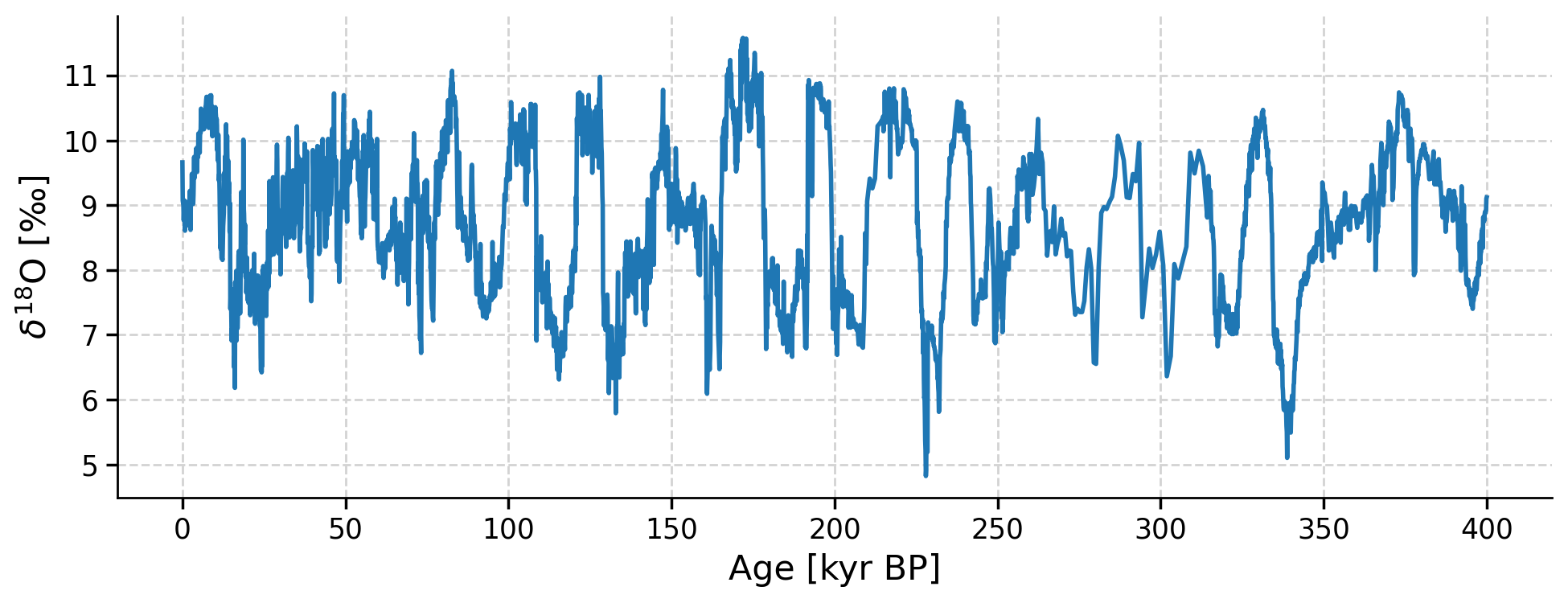
You may notice that in the figure we just made, the δ18O values on the y-axis is plotted with more positive values up, whereas in previous tutorials, we’ve plotted isotopic data with more negative values up (since more negative/“depleted” suggests warmer temperatures or increased rainfall). However, the pre-processed δ18O data that we’re using in this tutorial was multipled by -1, so now a more positive/“enriched” value suggests warmer temperatures or increased rainfall. In other words, in this figure, upward on the y-axis is increased monsoon intensity and downward on the y-axis is decreased monsoon intensity.
Let’s apply what we learned in the previous tutorial to perform spectral analysis on the speleothem oxygen isotope data. Recall from the previous tutorial that spectral analysis can help us identify dominant cyclicities in the data, which can be useful for assessing potential climate forcings.
Here we’ll use the Weighted Wavelet Z-Transform (WWZ) method you learned about in the previous tutorial:
# standardize the data
d18O_stnd = d18O_data.interp(step=0.5).standardize() # save it for future use
# calculate the WWZ spectral analysis
d18O_wwz = d18O_stnd.spectral(method="wwz")
# plot WWZ results
d18O_wwz.plot(xlim=[100, 5], ylim=[0.001, 1000])
(<Figure size 1000x400 with 1 Axes>,
<Axes: xlabel='Period [kyr]', ylabel='PSD'>)
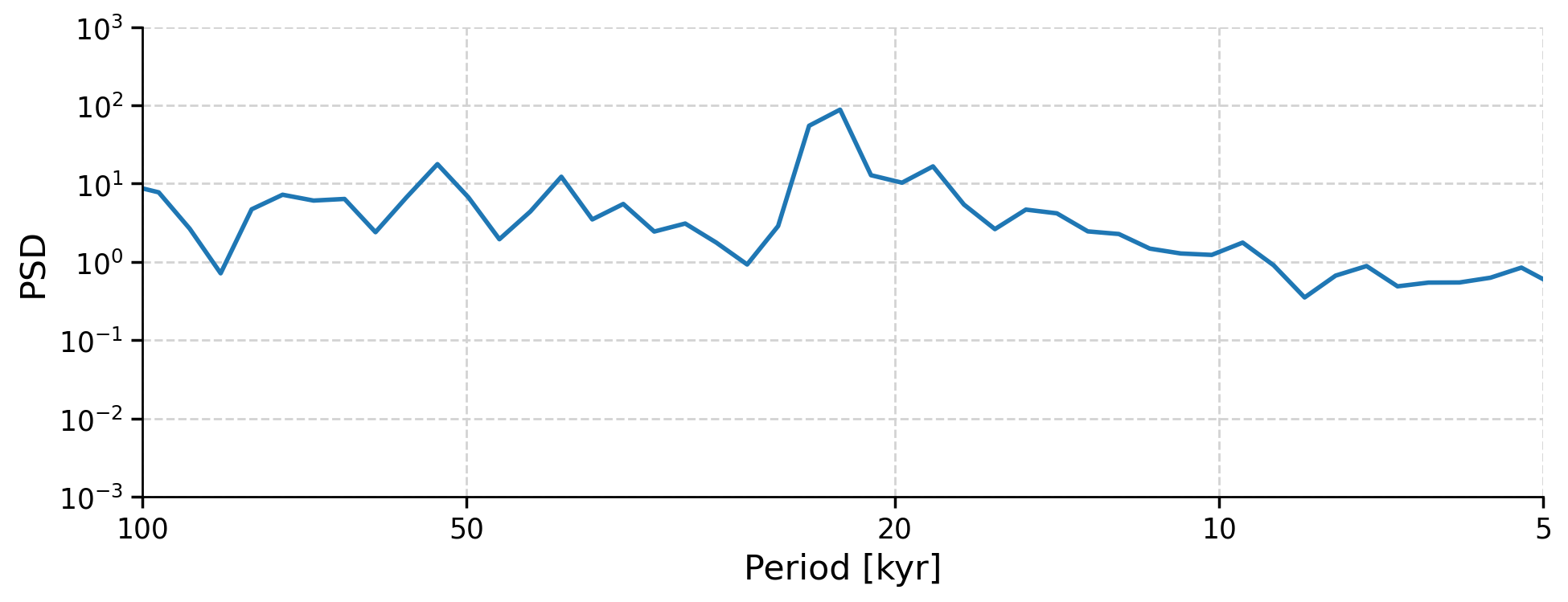
Coding Exercises 1#
The dominant spectral power is at ~23,000 years. This suggests a link between monsoon intensity and orbital precession! Is this peak significant? Use the skills you learned in the last tutorial to test the significance of this peak at the 95% confidence level. For this exercise, input
number = 30as the default value which will take a long time to run.
# perform significance test with 5 surrogates
d18O_wwz_sig = ...
# plot the results
_ = ...
Example output:
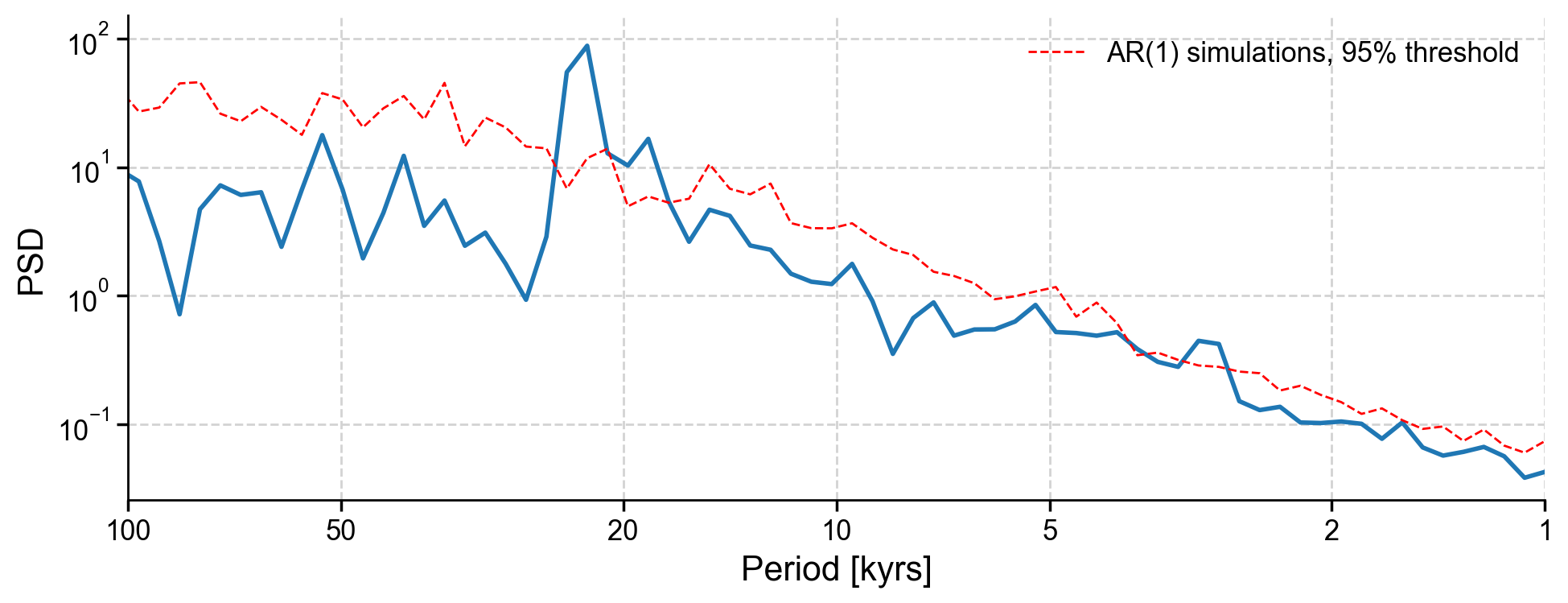
Submit your feedback#
Show code cell source
# @title Submit your feedback
content_review(f"{feedback_prefix}_Coding_Exercises_1")
Section 2: Constructing Insolation Curves#
To further explore and confirm the relationship between monsoon intensity and orbital precession, let’s take a look at insolation data and compare this to the speleothem δ18O records from Asia. Recall that insolation is controlled by variations in Earth’s orbital cycles (eccentricity, obliquity, precession), so by comparing the δ18O record to insolation, we can assess the influence of orbital variations on δ18O and monsoon intensity.
To compute solar insolation, we can use the package climlab by Brian Rose. Let’s create a time series over the past 400,000 years of changes in summer insolation at 31.67ºN, which is the latitude of Sanbao, one of the caves from which the speleothem records were produced.
# specify time interval and units
kyears = np.linspace(-400, 0, 1001)
# subset of orbital parameters for specified time
orb = OrbitalTable.interp(kyear=kyears)
days = np.linspace(0, const.days_per_year, 365)
# generate insolation at Sanbao latitude (31.67)
Qsb = daily_insolation(31.67, days, orb)
# julian days 152-243 are JJA
Qsb_jja = np.mean(Qsb[:, 151:243], axis=1)
Now we can store this data as a Series in Pyleoclim and plot the data versus time:
ts_qsb = pyleo.Series(
time=-kyears,
time_name="Age",
time_unit="ky BP",
value=Qsb_jja,
value_name="JJA Insolation",
value_unit=r"$W.m^{-2}$",
)
ts_qsb.plot()
Time axis values sorted in ascending order
(<Figure size 1000x400 with 1 Axes>,
<Axes: xlabel='Age [ky BP]', ylabel='JJA Insolation [$W.m^{-2}$]'>)

Next, let’s plot and compare the speleothem δ18O data and the solar insolation data:
# standardize the insolation data
ts_qsb_stnd = ts_qsb.standardize()
# create a MultipleSeries of the speleothem d18O record and insolation data
compare = [d18O_stnd, ts_qsb_stnd]
ms_compare = pyleo.MultipleSeries(compare, time_unit="kyr BP", name=None)
# create a stackplot to compare the data
ms_compare.stackplot()
(<Figure size 800x600 with 3 Axes>,
{0: <Axes: ylabel='$\\delta^{18}$O [‰]'>,
1: <Axes: ylabel='JJA Insolation [$W.m^{-2}$]'>,
'x_axis': <Axes: xlabel='Age [ka]'>})
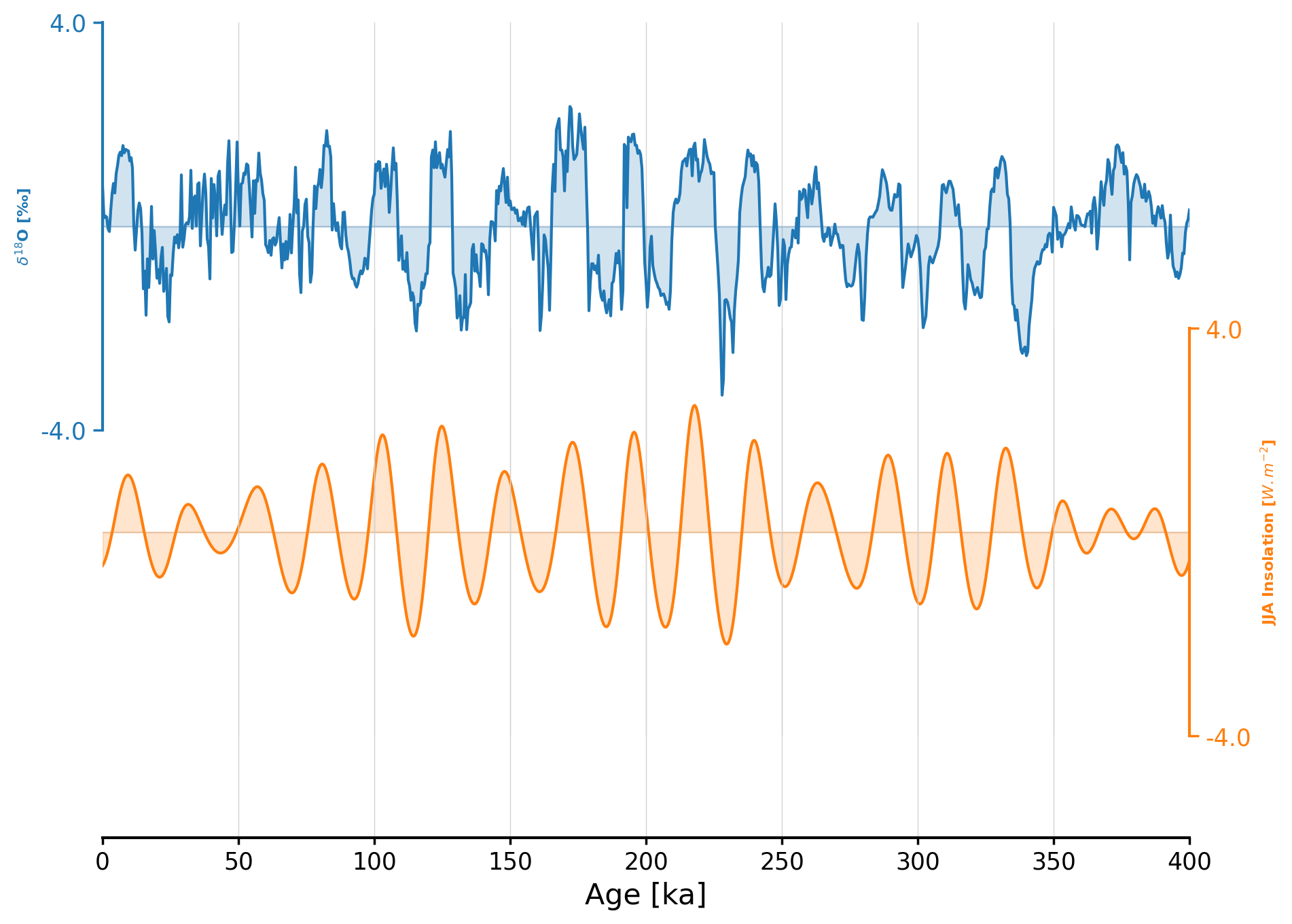
By visually comparing the time series of the two records, we can see similarites at orbital scales. To confirm this, we can use spectral analysis to determine the dominant spectral power of the insolation data:
# calculate the WWZ spectral analysis
psd_wwz = ts_qsb_stnd.spectral(method="wwz")
psd_wwz.plot()
(<Figure size 1000x400 with 1 Axes>,
<Axes: xlabel='Period [ky]', ylabel='PSD'>)
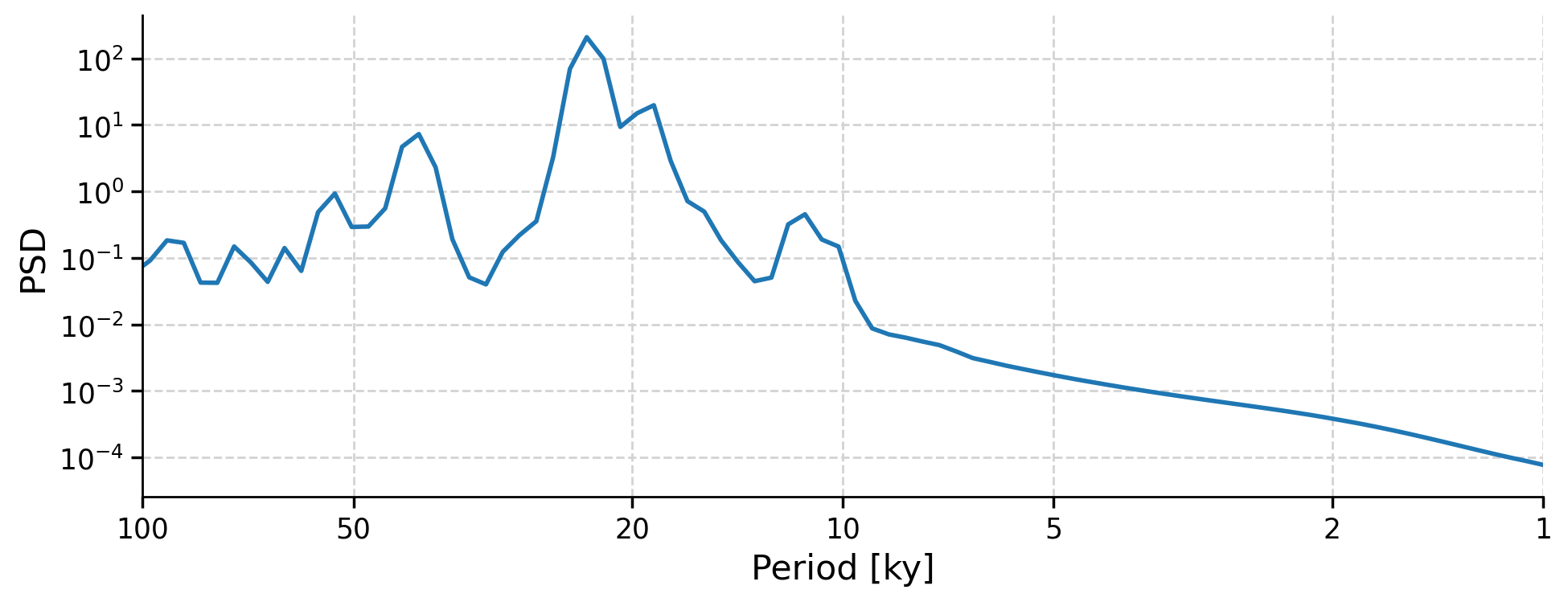
Questions 2: Climate Connection#
What is the dominant spectral power in summer insolation at 31ºN latitude? How does this compare to the speleothem data?
Why might there be a relationship between solar insolation and monsoon intensity? What does the common spectral power in both the insolation and δ18O records suggest about the climate forcings driving monsoon intensity in this region?
Submit your feedback#
Show code cell source
# @title Submit your feedback
content_review(f"{feedback_prefix}_Questions_2")
Summary#
In this tutorial, you’ve gained valuable insights into the complex world of paleoclimatology and climate forcings. Here’s a recap of what you’ve learned:
You’ve discovered how to plot and interpret temperature reconstructions derived from speleothem oxygen isotopes.
You’ve assessed the likely impact of orbital forcings on monsoon intensity over the past 400,000 years using spectral analysis.
By comparing the δ18O record to insolation, you’ve developed a deeper understanding of the relationship between solar insolation and monsoon intensity.
Resources#
Code for this tutorial is based on an existing notebook from LinkedEarth that explore forcing and responses in paleoclimate data.
Data from the following sources are used in this tutorial:
Cheng, H., Edwards, R., Sinha, A. et al. The Asian monsoon over the past 640,000 years and ice age terminations. Nature 534, 640–646 (2016). https://doi.org/10.1038/nature18591


